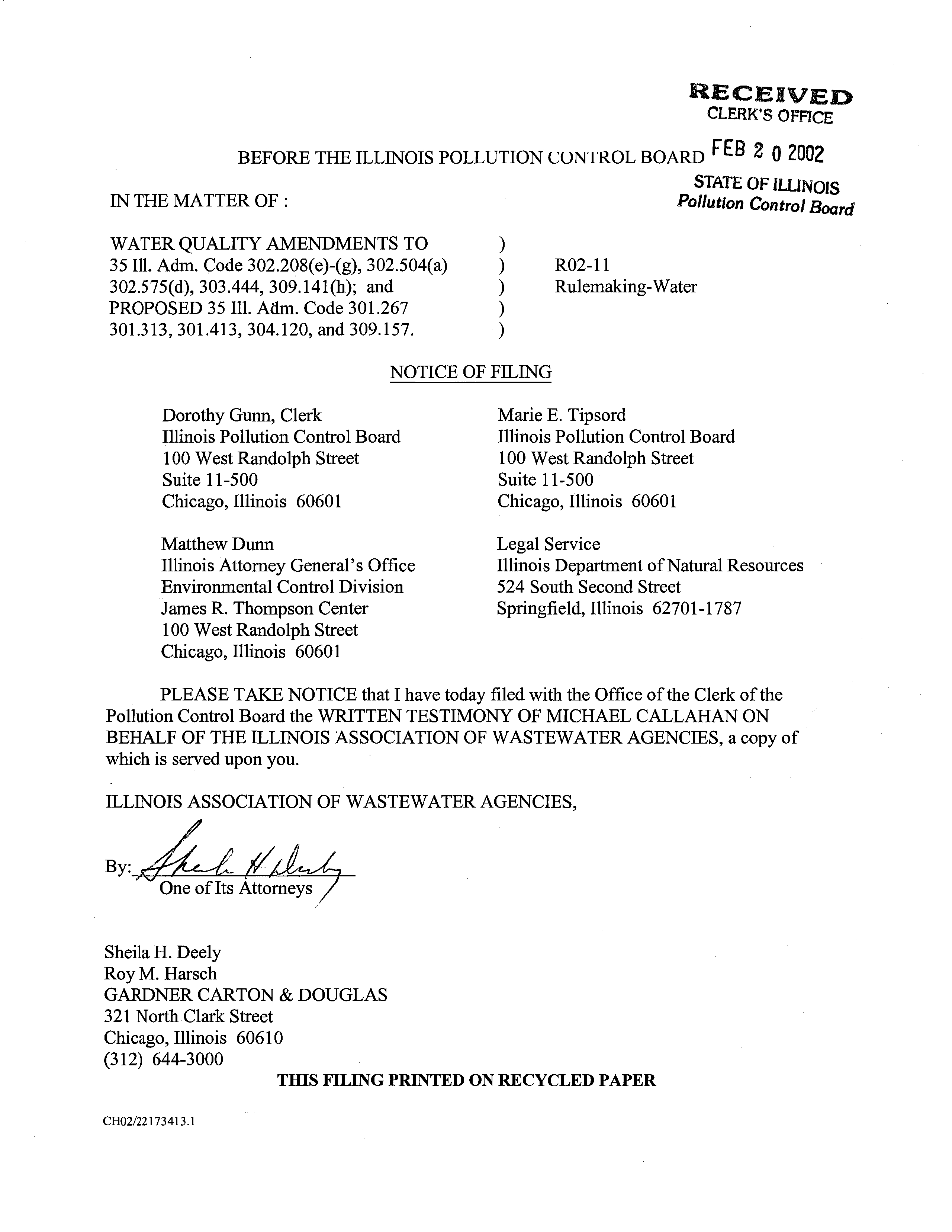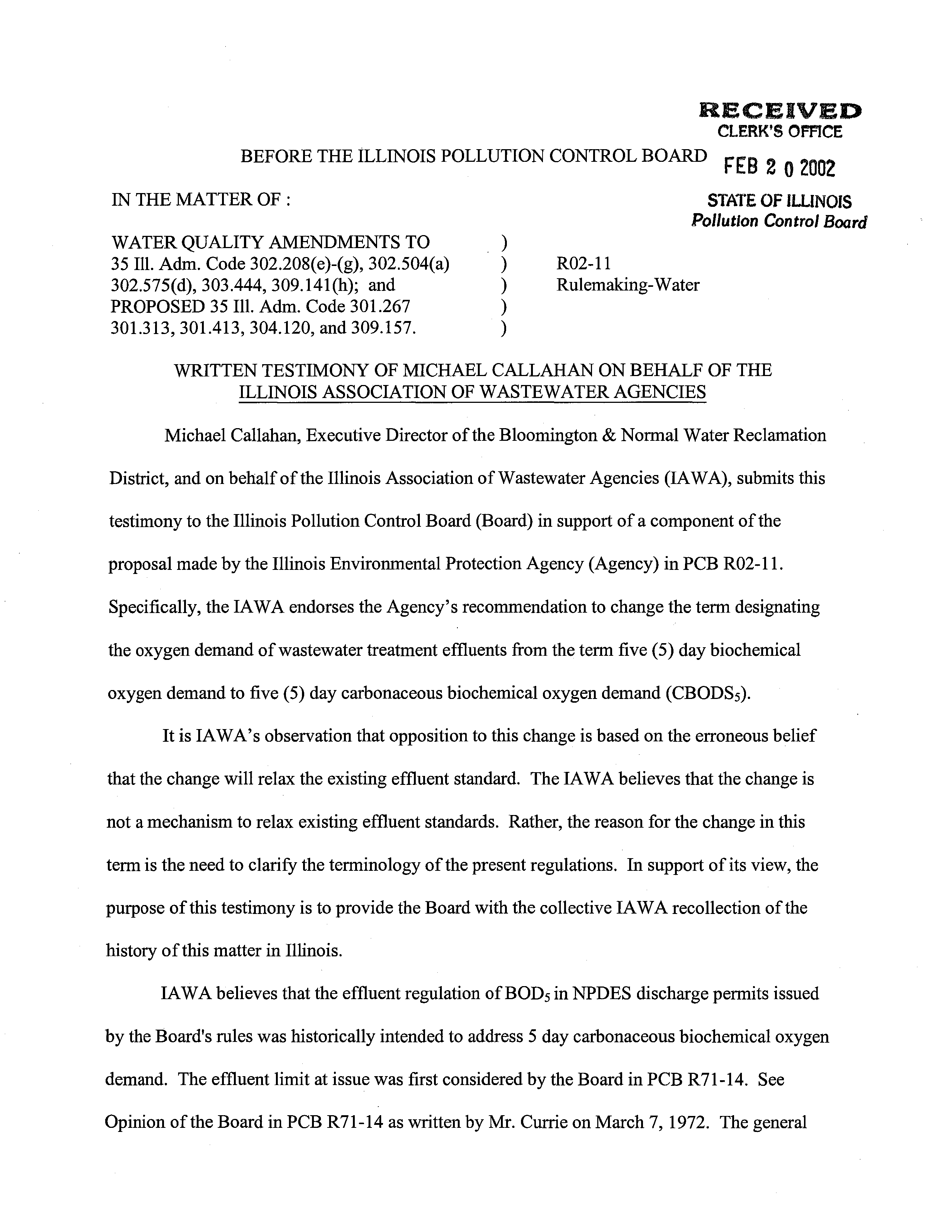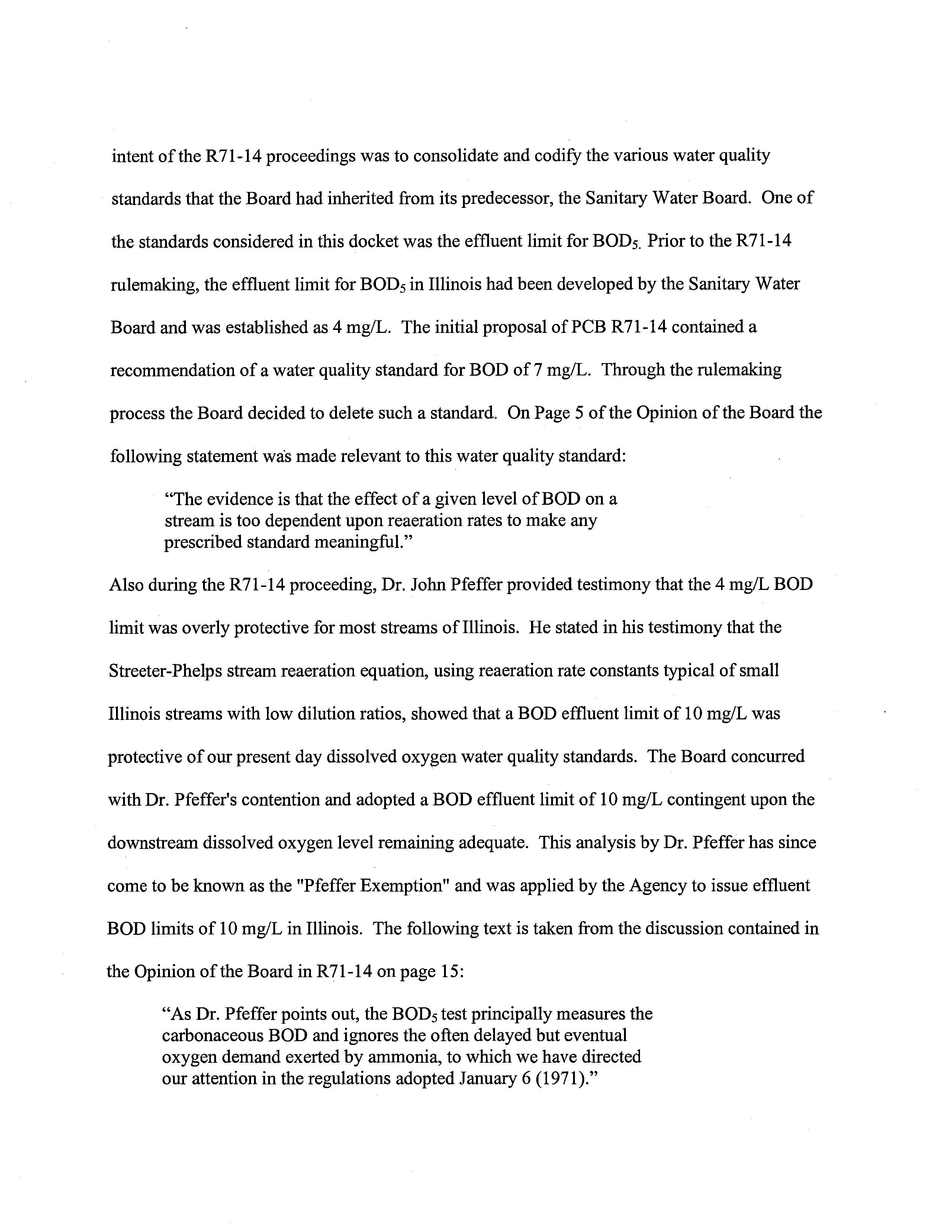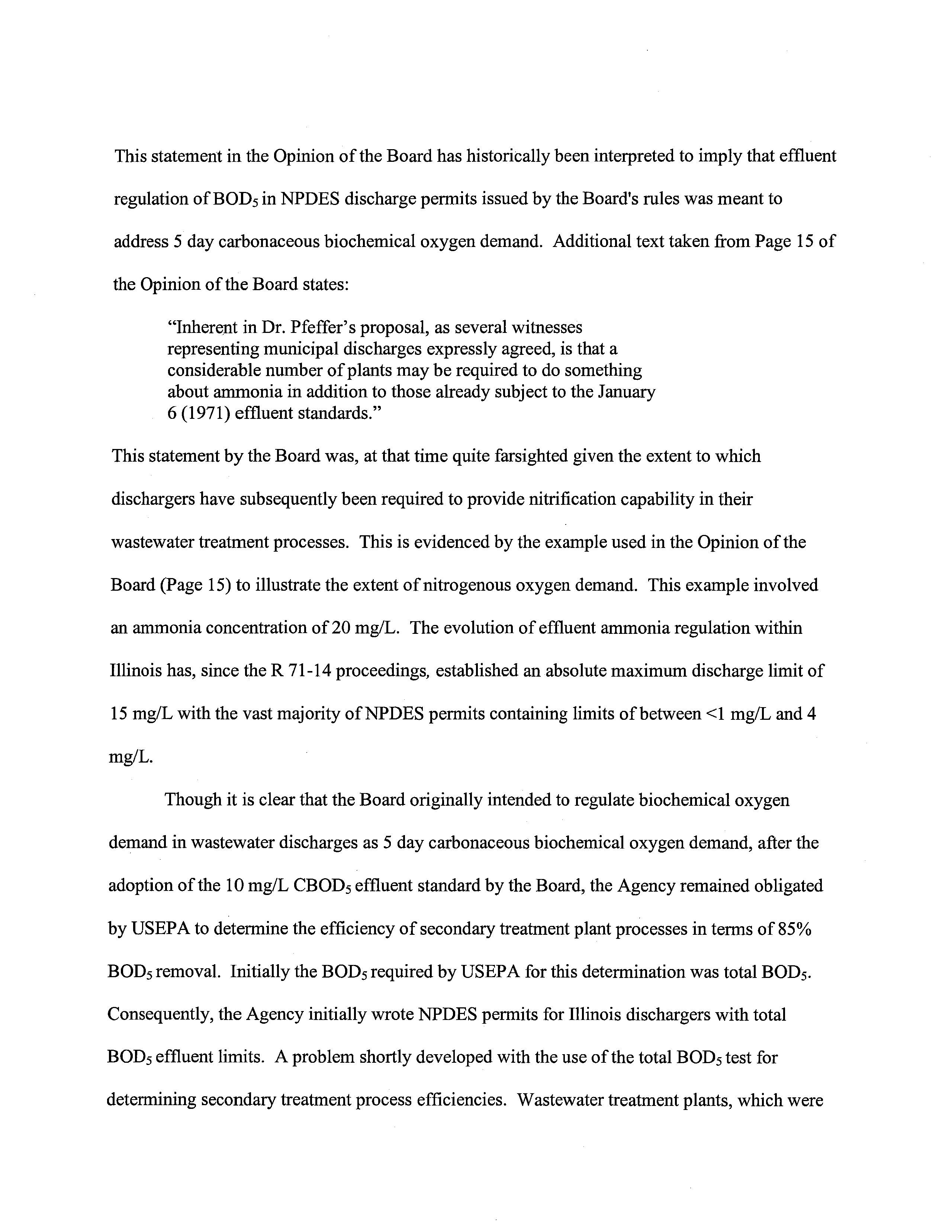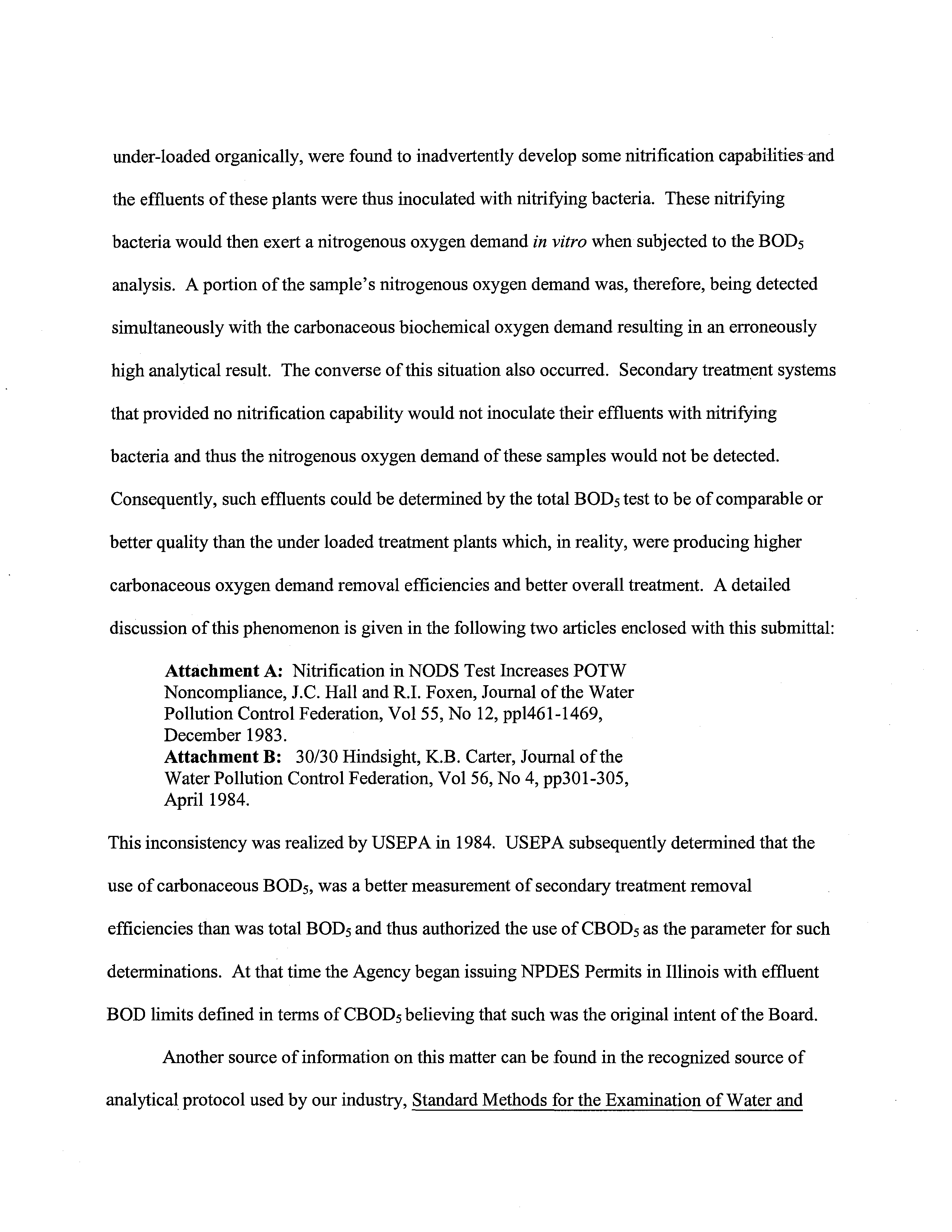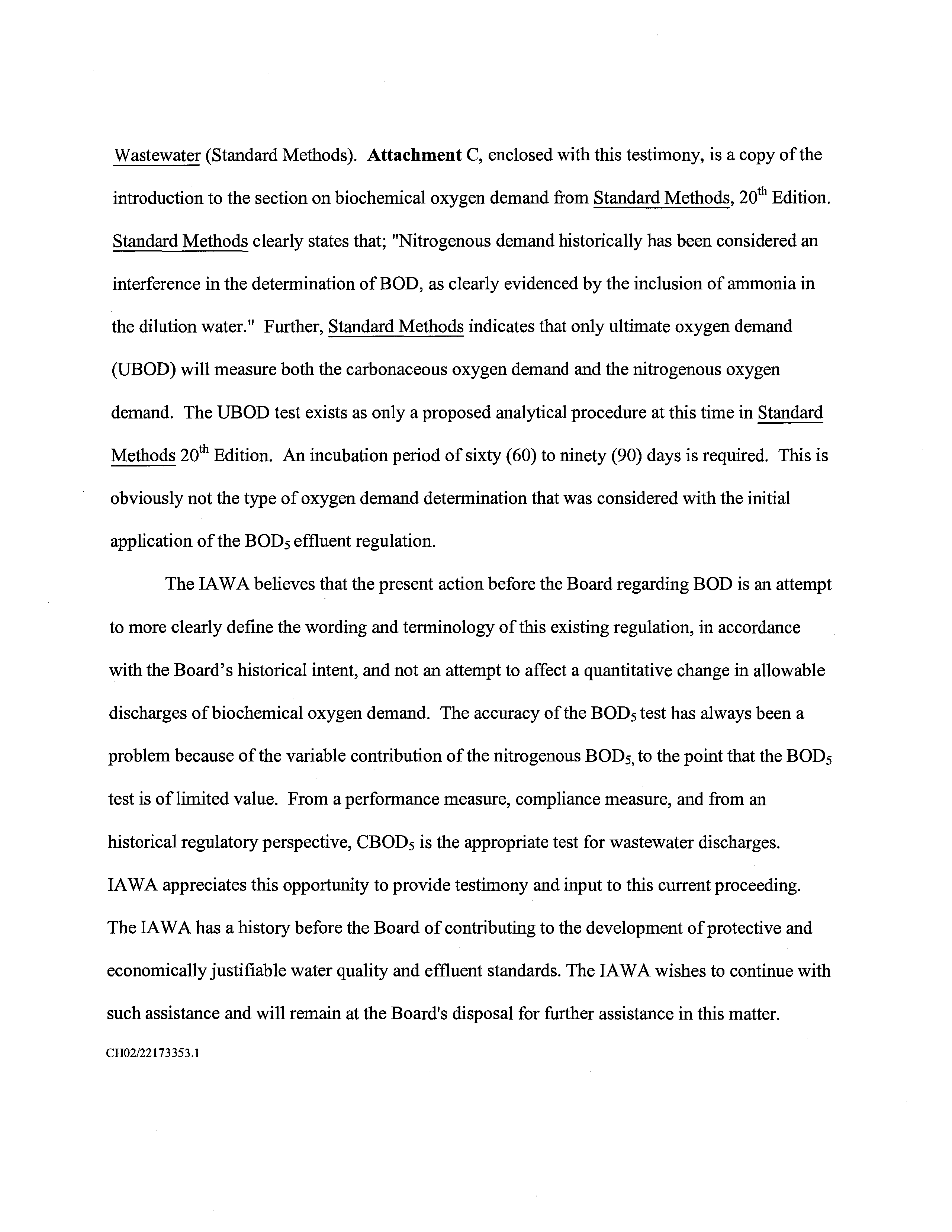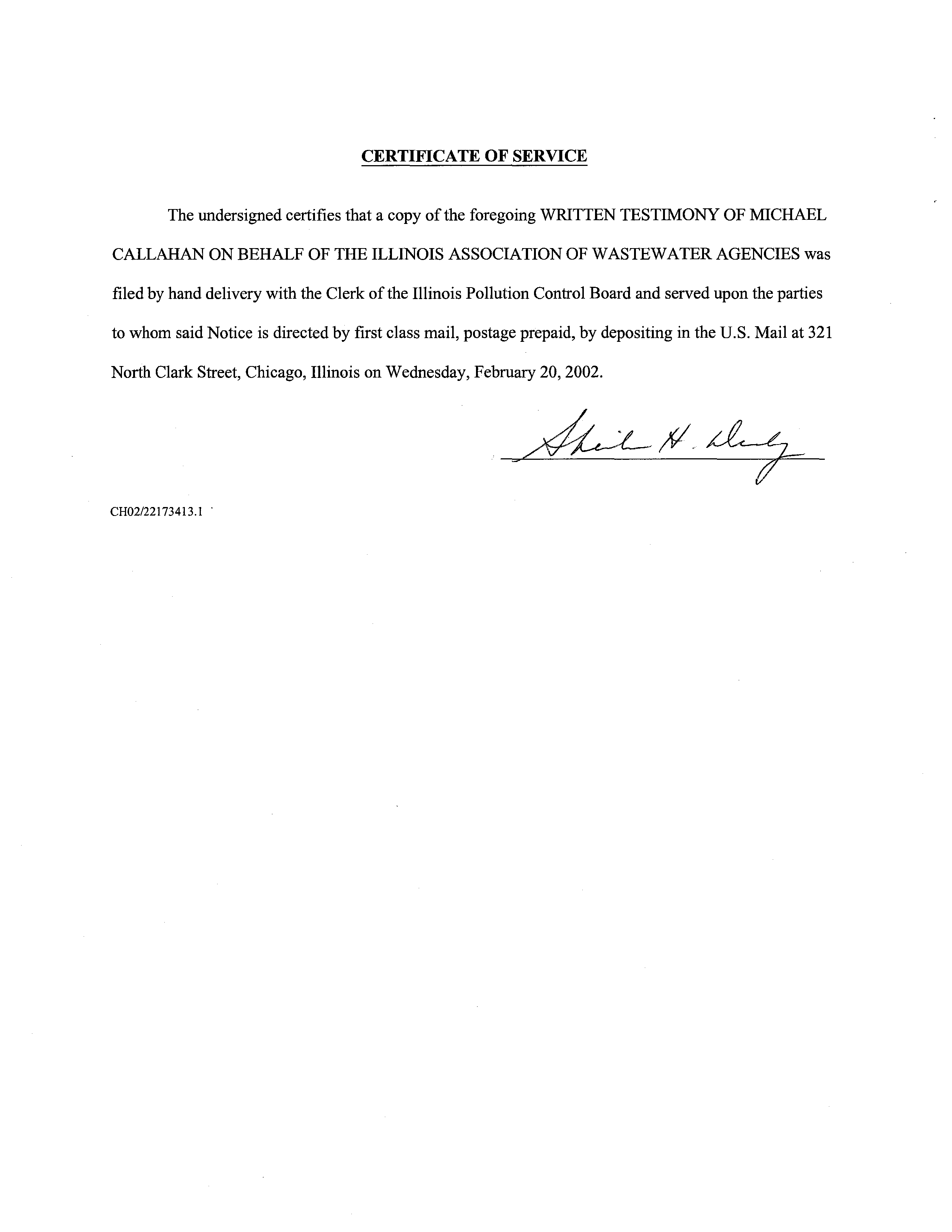RECE~YED
CLERK’S
OFFICE
BEFORE THE ILLINOIS POLLUTION CON’IROL BOARD
FEB
2
0
2002
IN THE MATTER OF:
WATER QUALITY AMENDMENTS TO
35
Iii. Adm.
Code 302.208(e)-(g), 302.504(a)
302.575(d),
303.444, 309.141(h);
and
PROPOSED
35
Ill. Adm.
Code 301.267
301.313, 301.413,
304.120, and
309.157.
NOTICE OF FILING
STATE OF IWNOIS
Pollution
Control Board
Dorothy Gurin, Clerk
Illinois Pollution Control Board
100 West Randolph Street
Suite 11-500
Chicago, Illinois
60601
Matthew Dunn
Illinois Attorney General’s Office
Environmental Control Division
James R. Thompson Center
100 West Randolph Street
Chicago, Illinois
60601
Marie E.
Tipsord
Illinois Pollution Control Board
100 West Randolph Street
Suite 11-500
Chicago, Illinois
60601
Legal Service
Illinois Department ofNatural Resources
524 South
Second Street
Springfield, Illinois
62701-1787
PLEASE TAKE NOTICE that I have today filedwith the Office ofthe Clerk ofthe
Pollution Control Board the WRITTEN TESTIMONY OF MICHAEL CALLAHAN ON
BEHALF OF THE ILLINOIS ASSOCIATION OF
WASTEWATERAGENCIES,
a copy of
which is served upon you.
ILLINOIS ASSOCIATION OF WASTEWATER AGENCIES,
By:~
~
One ofIts Attorneys
Sheila H. Deely
Roy M. Harsch
GARDNER CARTON & DOUGLAS
321
North Clark Street
Chicago, Illinois
60610
(312)
644-3000
TifiS FILING PRINTED ON RECYCLED PAPER
)
)
)
)
)
R02-1
1
Rulemaking-Water
CHO2/22 173413.1
RECEiVED
CLERK’S
OFFICE
BEFORE THE ILLINOIS POLLUTION CONTROL BOARD
FEB
2
02002
IN THE MATTER OF:
STATE OF ILLINOIS
Pollution
Control Board
WATER QUALITY AMENDMENTS TO
)
35 Ill.
Adm. Code 302.208(e)-(g), 302.504(a)
)
R02-1
1
302.575(d),
303.444, 309.141(h);
and
)
Rulemaking-Water
PROPOSED
35 Ill. Adm. Code 301.267
)
301.313, 301.413, 304.120,
and 309.157.
)
WRITTEN TESTIMONY OF MICHAEL CALLAHAN ON BEHALF OF THE
ILLINOIS ASSOCIATION OF WASTEWATER AGENCIES
Michael Callahan, Executive Director of the Bloomington & Normal Water Reclamation
District, and on behalfofthe Illinois Association of Wastewater Agencies (IAWA), submits this
testimony to the Illinois Pollution Control Board (Board) in support
ofa component ofthe
proposal made by the Illinois Environmental Protection Agency (Agency) in PCB R02-1 1.
Specifically, the IAWA endorses the Agency’s recommendation to change the term designating
the oxygen demand ofwastewater treatment effluents from the term five
(5)
day biochemical
oxygen demandto five
(5)
day carbonaceous biochemical oxygen demand (CBODS5).
It is IAWA’s observation that opposition to this change is based on the erroneous belief
that the change will relax the existing effluent standard.
The IAWA believes that the change is
not
a mechanism to relax existing effluent standards.
Rather, the reason for the change in this
termis the need to
clarify the terminology ofthe present regulations.
In support ofits view, the
purpose ofthis testimony is
to provide the Board with the collective IAWA recollection ofthe
history ofthis matter in Illinois.
IAWAbelieves that the effluent regulation of BOD5 in NPDES
discharge permits issued
by the Board’s rules was historically intended to address
5
day carbonaceous biochemical oxygen
demand.
The effluent limit at issue was first considered by the Board in PCB R71-14.
See
Opinion ofthe Board in PCB R71-14
as written by Mr. Currie on March 7,
1972.
The general
intent ofthe R71-14 proceedings was to consolidate and codify the various water quality
standards that the Board had inherited
from its predecessor, the Sanitary Water Board.
One of
the standards considered in this docket was the effluent limitfor BOD5
Prior to
the R71-14
rulemaking, the effluent limit for BOD5 in Illinois had been developed by the Sanitary Water
Board and was established as 4 mg/L.
The initial proposal of PCB R71-14
contained a
recommendation ofa water quality standard for BOD of7 mg/L.
Through the rulemaking
process the Board decided to delete such a standard.
On Page
5
ofthe Opinion ofthe Board the
following statementwas made relevant to this waterquality standard:
“The evidence is that the effect of a given level ofBOD on a
stream is too dependent upon reaeration rates to make any
prescribed standard meaningful.”
Also during the R71-14 proceeding, Dr. John Pfeffer provided testimony that the 4 mg/L BOD
limit was overly protective for most streams ofIllinois.
He stated in his testimony that the
Streeter-Phelps stream reaeration equation, using reaerationrate constants typical ofsmall
Illinois streams with low dilution ratios, showed that a BOD effluent limit of 10 mg/L was
protective ofourpresent day dissolved oxygen water quality standards.
The Board concurred
with Dr. Pfeffer’s contention and adopted a BOD effluent limit of 10 mg/L
contingent upon the
downstream dissolved oxygen level remaining adequate.
This analysis by Dr. Pfeffer has since
come to be known as the “Pfeffer Exemption” and was applied by the Agency to issue effluent
BOD limits of 10 mg/L in Illinois.
The following text
is taken from the discussion contained in
the Opinion of the Board in R71-14
on page
15:
“As Dr. Pfeffer points out, the BOD5test principally measures the
carbonaceous BOD and ignores the often delayed but eventual
oxygen demand exerted by ammonia, to
which we have directed
our attention in the regulations adopted January 6 (1971).”
This statement in the Opinion ofthe Board has historically been interpreted to
imply that effluent
regulation ofBOD5 in NPDES discharge permits issued by the Board’s rules was meant to
address
5
day carbonaceous biochemical oxygen demand.
Additional text taken from Page 15 of
the Opinion ofthe Board states:
“Inherent
in Dr. Pfeffer’s proposal, as several witnesses
representing municipal discharges expressly agreed, is
that a
considerable
number ofplants may be required to do something
about ammonia in addition to
those already subject to the January
6 (1971) effluent standards.”
This statement by the Board was, at that time quite farsighted given the extent to which
dischargers have subsequently been required to provide nitrification capability in their
wastewatertreatment processes.
This is evidenced by the example used in the Opinion ofthe
Board (Page
15)
to
illustrate the extent ofnitrogenous oxygen demand.
This example involved
an ammonia concentration of20 mg/L.
The evolution ofeffluent ammonia regulation within
Illinois has, since the R 71-14 proceedings, established an absolute maximum discharge limit of
15 mg/L with the vast majority ofNPDES permits containing limits ofbetween 1
mg/L
and 4
mg/L.
Though it is clear that the Board originally intended to regulate biochemical oxygen
demand in wastewater discharges as
5
day carbonaceous biochemical oxygen demand, after the
adoption ofthe 10 mg/L
CBOD5 effluent standard by the Board, the Agency remained obligated
by USEPA to determine the efficiency ofsecondary treatment plant processes in terms of
85
BOD5 removal.
Initially the BOD5 required by USEPA for this determination was total BOD5.
Consequently, the Agency initially wrote NPDES permits for Illinois dischargers with total
BOD5 effluent limits.
A problem shortly developed with the use ofthe total BOD5 test for
determining secondary treatment process efficiencies.
Wastewater treatment plants, which were
under-loaded organically, were found to inadvertently develop some nitrification capabilities-and
the effluents ofthese plants were thus inoculated with nitrifying bacteria.
These nitrifying
bacteria would then exert a nitrogenous oxygen demand
in vitro
when subjected to
the BOD5
analysis.
A portion ofthe sample’s nitrogenous oxygen demand was, therefore, being detected
simultaneously with the carbonaceous biochemical oxygen demand resulting in an erroneously
high analytical result.
The converse ofthis situation also occurred.
Secondary treatment systems
that provided no nitrification capability would not inoculate their effluents with nitrifying
bacteria and thus the nitrogenous oxygen demand of these samples would not be detected.
Consequently, such effluents could be determined by the total
BOD5 test to be ofcomparable or
better quality than the under loaded treatment plants
which, in reality, were producing higher
carbonaceous oxygen demand removal efficiencies and better overall treatment.
A detailed
discussion ofthis phenomenon is given in the following two articles enclosed with this submittal:
Attachment
A:
Nitrification in NODS Test Increases POTW
Noncompliance, J.C. Hall and R.I. Foxen, Journal ofthe Water
Pollution Control Federation, Vol
55,
No 12,
ppl46l-l469,
December 1983.
Attachment
B:
30/30 Hindsight, K.B. Carter, Journal ofthe
Water Pollution Control Federation, Vol
56, No 4, pp30 1-305,
April 1984.
This inconsistency was realized by USEPA in 1984.
USEPA subsequently determined that the
use of carbonaceous BOD5, was a better measurement ofsecondary treatment removal
efficiencies than was total BOD5 and thus authorized the use ofCBOD5 as the parameter for such
determinations.
At that time the Agency began issuing NPDES Permits in Illinois with effluent
BOD limits defined in terms of CBOD5 believing that such was the original intent ofthe Board.
Another source ofinformation on this matter canbe
found in the recognized source of
analytical protocol used by our industry, Standard Methods for the Examination ofWater and
Wastewater (Standard Methods).
Attachment C,
enclosed with this testimony,
is a copy ofthe
introduction to the section on biochemical oxygen demand from Standard Methods,
20th
Edition.
Standard Methods clearly states that;
“Nitrogenous demand historically has been considered an
interference in the determination ofBOD,
as clearly evidenced by the inclusion ofammonia in
the dilution water.”
Further, Standard Methods
indicates that only ultimate oxygen demand
(UBOD) will measure both the carbonaceous oxygen demand and the nitrogenous oxygen
demand.
The UBOD test exists as only a proposed analytical procedure at this time in Standard
Methods
20th
Edition.
An incubation period ofsixty (60) to ninety
(90) days is required.
This is
obviously not the type of oxygen demand determination that was considered with the initial
application of the BOD5 effluent regulation.
The IAWA believes that the present action before the Board regarding BOD is an attempt
to more clearly define the wording and terminology ofthis existing regulation, in accordance
with the Board’s historical intent,
and not an
attempt to
affect
a quantitative change in allowable
discharges ofbiochemical oxygen demand.
The accuracy ofthe BOD5 test has always been a
problem because ofthe variable contribution ofthe nitrogenous BOD5, to the point that the BOD5
test is oflimited value.
From a performance measure, compliance measure, and from an
historical regulatory perspective, CBOD5 is the appropriate test for wastewater discharges.
IAWA appreciates this opportunity to provide testimony and input to this current proceeding.
The JAWA has a history before the Board ofcontributing to the development ofprotective and
economicallyjustifiable waterquality and effluent standards. The IAWAwishes to continue with
such assistance and will remain at the Board’s disposal for further assistance in this matter.
CI-102122173353.1
CERTIFICATE OF SERVICE
The
undersigned
certifies that
a
copy ofthe foregoing WRIFFEN TESTIMONY OF MICHAEL
CALLAHAN ON BEHALF OF THE ILLiNOIS ASSOCIATION OF WASTEWATER AGENCIES was
flied by hand delivery with the Clerk of the Illinois Pollution Control Board and served upon the parties
to whom saidNotice is directed by first class mail, postage prepaid, by depositing in the U.S. Mail at 321
North Clark Street, Chicago, Illinois on Wednesday, February 20, 2002.
CHO2/22173413.1
